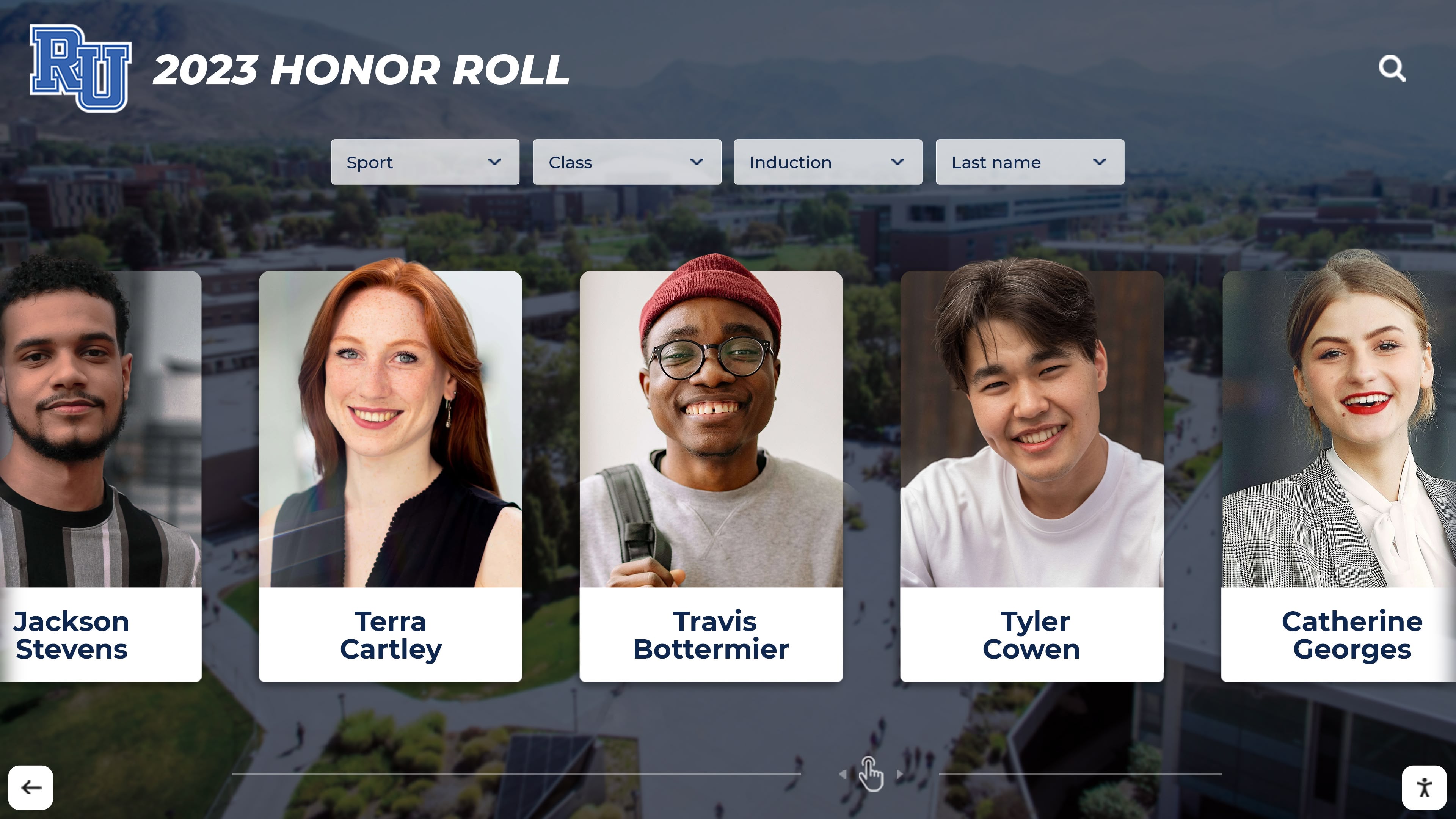Key Takeaways
Complete guide to implementing academic Student of the Month digital display programs in schools. Learn how interactive touchscreen technology transforms recognition, boosts engagement, and builds positive school culture through modern celebration systems.
The Evolution of Student of the Month Recognition
Student of the Month programs have been a fixture in American schools for decades, designed to acknowledge outstanding achievement, character, and contribution beyond traditional grade-based recognition. Understanding how these programs have evolved helps schools implement more effective modern approaches.
Traditional Recognition Methods and Their Limitations
Conventional Student of the Month programs typically follow predictable patterns: teachers nominate students based on established criteria, selection committees review nominations, winners receive certificates during brief announcements, and names appear on bulletin boards or newsletters. While these elements provide acknowledgment, they face significant effectiveness challenges.
Physical Display Constraints: Traditional bulletin boards in school hallways accommodate limited information—typically just student names and perhaps small photographs. This minimal presentation fails to tell the complete story of why honorees earned recognition or what makes their achievements meaningful. Visitors and even students regularly pass these displays without noticing or engaging with the content.
Temporary Visibility: Most schools replace Student of the Month displays each month, meaning recognition visibility lasts only 30 days before being removed to make room for next month’s honorees. This ephemeral approach prevents cumulative recognition documenting achievement patterns over time and limits motivational impact to brief windows.
Limited Accessibility: Physical displays reach only those who physically pass specific hallway locations during school hours. Families, extended relatives, community members, and even students in different building areas often never see recognition, dramatically reducing program reach and impact.
Labor-Intensive Updates: Creating monthly bulletin board displays requires printing certificates, mounting photographs, updating name cards, and physically traveling to display locations—tasks consuming significant staff time that could be invested in more impactful activities.
According to research from the National Center for Education Statistics, schools using interactive touchscreens saw a 25% increase in student engagement and participation compared to traditional display methods. These limitations explain why many Student of the Month programs feel routine rather than exciting despite good intentions.
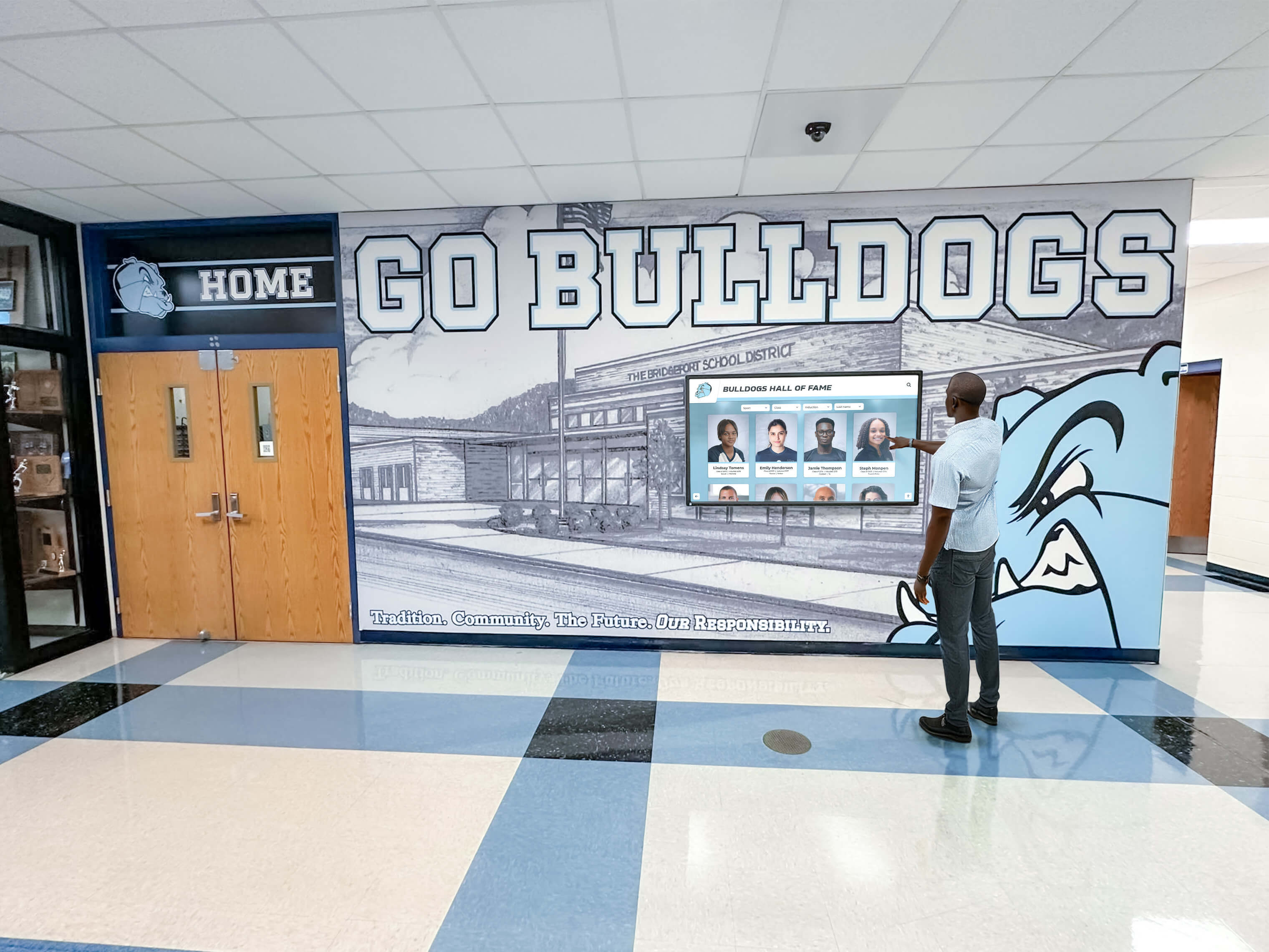
Why Digital Recognition Transforms Impact
Modern digital display technology addresses traditional limitations while creating entirely new possibilities for meaningful student recognition. The transformation extends far beyond simply replacing paper with screens.
Multimedia Storytelling Capabilities: Digital platforms enable rich recognition far beyond simple name listings. Schools can showcase professional student photographs, detailed achievement descriptions, personal statements from honorees, teacher testimonials explaining significance, video content featuring student interviews, and comprehensive profiles celebrating well-rounded accomplishment. This depth makes recognition genuinely engaging and memorable.
Permanent Historical Archives: Unlike temporary bulletin boards, digital systems maintain permanent searchable archives documenting every Student of the Month honoree across years and decades. Current students can explore complete recognition histories, families can find their own achievements years later, and schools build institutional traditions celebrating excellence across generations.
Interactive Engagement Features: Touchscreen technology transforms passive observation into active exploration. Students, families, and visitors can search by name, browse by month or year, filter by grade level or achievement category, view detailed honoree profiles, and discover recognition patterns. This interactivity creates meaningful engagement rather than quick hallway glances.
Effortless Content Management: Cloud-based platforms allow authorized staff to update recognition displays from any internet-connected device within minutes. Adding new honorees, updating photographs, or modifying descriptions requires no technical expertise or physical presence at display locations, dramatically reducing administrative burden while ensuring timely updates.
Research shows that schools incorporating cloud-based digital recognition systems experienced a 40% higher rate of parental involvement and community engagement compared to traditional approaches. This increased engagement creates recognition programs that genuinely influence school culture rather than fading into background noise.
Understanding Student of the Month Program Objectives
Before implementing digital displays, schools should clarify what Student of the Month programs aim to accomplish and ensure recognition approaches support those objectives effectively.
Academic Excellence Recognition
Many Student of the Month programs focus primarily or exclusively on academic achievement—honor roll performance, grade improvement, exceptional work in specific subjects, or outstanding effort and study habits. Academic-focused recognition validates scholarly accomplishment and communicates institutional commitment to learning excellence.
GPA-Based Recognition: Some schools establish minimum grade point average thresholds for Student of the Month eligibility, ensuring honorees demonstrate strong overall academic performance. This approach provides objective criteria while motivating students toward specific achievement targets.
Improvement-Centered Recognition: Rather than absolute achievement levels, improvement-focused programs acknowledge students making significant academic progress regardless of starting points. A student improving from failing grades to passing deserves celebration equal to peers maintaining perfect grades, as improvement demonstrates dedication and growth.
Subject-Specific Excellence: Monthly recognition rotated among academic departments allows subject specialists to identify students demonstrating exceptional capability, creativity, or progress in particular disciplines. This approach ensures diverse recognition across mathematics, science, English, social studies, world languages, and arts rather than repeatedly acknowledging the same highest-achieving students.
Solutions like digital recognition displays for celebrating academic excellence provide platforms specifically designed for showcasing scholarly achievement comprehensively.
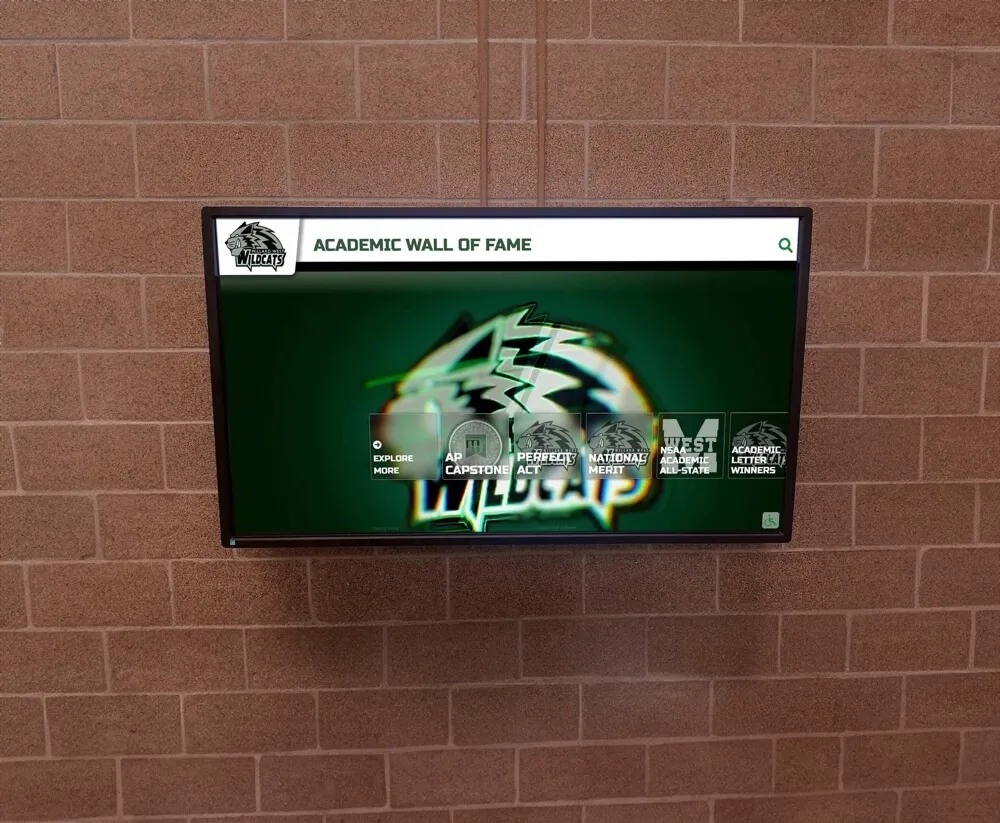
Character and Citizenship Recognition
Beyond academics, many Student of the Month programs emphasize character traits, citizenship, and positive contribution to school communities. This recognition acknowledges that education encompasses more than test scores and grade points.
Character Trait Focus: Schools establish monthly themes rotating through character traits like respect, responsibility, perseverance, integrity, kindness, leadership, or cooperation. Students demonstrating exceptional examples of featured traits earn recognition, creating intentional character education reinforcement.
Citizenship and Community Contribution: Recognition for students who consistently demonstrate good citizenship—following expectations, helping peers, contributing to positive classroom environments, participating in service, or showing school spirit—validates behaviors essential for healthy communities beyond academic metrics.
Overcoming Challenges: Students facing and overcoming significant obstacles—learning difficulties, personal challenges, attendance issues, behavioral growth—deserve acknowledgment when they demonstrate remarkable progress or resilience. This recognition communicates that schools notice and value effort regardless of circumstances.
Digital platforms supporting comprehensive student of the month programs enable schools to celebrate diverse achievement categories simultaneously without space constraints limiting recognition breadth.
Balanced Comprehensive Recognition
The most effective Student of the Month programs balance multiple recognition dimensions rather than focusing exclusively on academics or character. Comprehensive approaches ensure diverse students have realistic pathways to experience acknowledgment.
Rotating Recognition Categories: Schools can rotate monthly focus among academics, character, arts, athletics, service, and leadership, ensuring various achievement types receive consistent visibility throughout school years. This rotation prevents programs from inadvertently favoring students with particular strengths while overlooking others making meaningful contributions in different areas.
Multiple Monthly Honorees: Rather than single Student of the Month per school, many institutions recognize multiple students—one per grade level, one per homeroom, or one from each academic department. Expanded recognition creates more frequent acknowledgment opportunities while maintaining meaningful selectivity at grade or department levels.
Inclusive Eligibility Standards: Establish clear, transparent criteria ensuring all students have realistic chances of earning recognition at some point. Programs where the same handful of highest-achieving students receive repeated acknowledgment while most peers never experience recognition fail to create broadly motivational cultures.
Selecting Appropriate Digital Display Technology
Schools face numerous technology options for Student of the Month digital recognition, each with distinct advantages, limitations, and ideal use cases.
Interactive Touchscreen Displays
Large interactive touchscreen displays mounted in high-traffic school locations provide prominent physical recognition creating visible institutional commitment to celebrating students.
Display Specifications: Professional-grade educational touchscreens typically range from 55 to 75 inches, providing sufficient size for hallway visibility while fitting standard mounting locations. Commercial-grade displays designed for continuous operation withstand constant use better than consumer televisions, making them appropriate for public institutional settings.
Interactive Capabilities: Touchscreen functionality transforms displays from passive announcements into engaging experiences. Students, families, and visitors can browse complete honoree archives, search for specific students, view detailed recognition profiles, watch video content, and explore achievement histories interactively rather than simply reading static lists.
Prominent Physical Presence: Large displays in main lobbies, cafeterias, or primary hallways create focal recognition points impossible to miss. This visibility communicates that schools prioritize student recognition enough to dedicate prominent physical space and significant resources, reinforcing recognition importance institutionally.
Investment Considerations: Professional touchscreen installations typically range from $6,500 to $15,000 for hardware, installation, and initial setup, with annual software subscriptions of $1,000 to $3,000 depending on features. While initial investment exceeds traditional bulletin boards, schools often find total cost of ownership favorable when considering labor savings, unlimited capacity, and enhanced engagement over multi-year periods.
Resources on selecting the best touchscreen displays for schools provide detailed guidance for evaluating hardware options based on specific institutional needs.
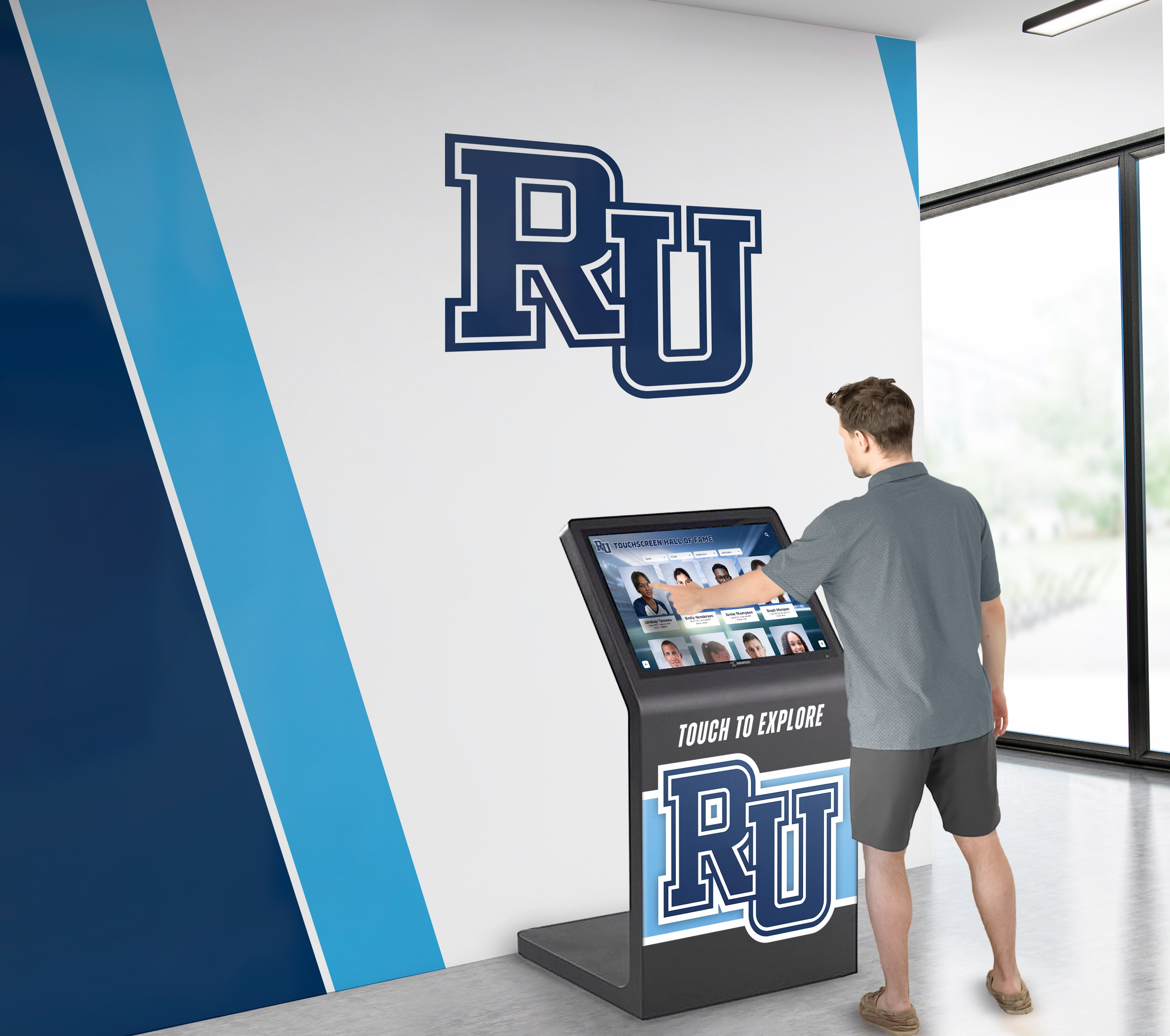
Web-Based Recognition Platforms
Digital recognition need not require physical displays. Web-based platforms provide universal access through existing computers, tablets, and smartphones without dedicated hardware investment.
Universal Accessibility: Web platforms allow viewing from anywhere with internet connectivity—homes, workplaces, or mobile devices—dramatically expanding recognition reach beyond those who physically visit school buildings. Families can explore recognition content during evenings and weekends when physical school access is unavailable.
Social Sharing Integration: Modern web platforms facilitate easy social media sharing, enabling families to celebrate achievements with extended networks. This amplification extends recognition visibility far beyond immediate school communities while providing positive school promotion through authentic family endorsements.
Lower Initial Investment: Web-based solutions require smaller upfront investments than physical displays, making them accessible for schools with constrained budgets. Annual subscription costs typically range from $2,000 to $8,000 depending on features, customization, and student population size.
Complementary to Physical Displays: Many schools implement hybrid approaches combining prominent physical touchscreens for on-campus visibility with web extensions enabling remote access. This combination maximizes recognition reach across multiple contexts and audiences.
Digital Signage Screens
Non-interactive digital signage displays provide middle-ground options between traditional bulletin boards and full interactive touchscreens.
Rotating Content Display: Digital signage screens automatically rotate through recognition content, announcements, and other information without user interaction. Student of the Month profiles can display prominently during portions of rotation cycles, ensuring regular visibility without constant manual updates.
Lower Cost Alternative: Digital signage displays cost significantly less than interactive touchscreens—typically $2,000 to $5,000 installed—while still providing dynamic digital content capabilities far exceeding static bulletin boards.
Limited Engagement: Non-interactive screens restrict audience engagement to passive viewing without exploration, search, or detailed content access. This limitation reduces impact compared to fully interactive systems but still represents significant improvement over paper-based approaches.
Multi-Purpose Functionality: Digital signage serves multiple institutional communication purposes beyond recognition—daily announcements, event promotion, lunch menus, emergency notifications—making investment easier to justify through diverse use cases.
Designing Compelling Student of the Month Content
Technology platforms enable recognition, but content quality determines whether programs genuinely engage and motivate. Effective digital recognition requires thoughtful content development approaches.
Creating Rich Student Profiles
Transform simple name listings into comprehensive profiles celebrating honorees meaningfully.
Professional Photography: High-quality student photographs create visual impact and personal connection impossible with names alone. Professional portraits or candid action shots showing students engaged in learning, leadership, or activities make recognition visually engaging while humanizing achievements.
Detailed Achievement Descriptions: Beyond generic “Student of the Month” labels, explain specifically why honorees earned recognition. What academic accomplishments, character demonstrations, improvement patterns, or contributions warranted selection? Specific descriptions help audiences understand achievement significance while providing concrete examples for peers to emulate.
Personal Statements from Honorees: Include brief quotes or reflections from recognized students about their achievement journey, what recognition means to them, advice for peers, or goals for the future. Personal voices make recognition authentic and relatable rather than purely institutional.
Teacher Testimonials: Faculty perspectives explaining why students deserved recognition add authority and context. Teachers can highlight specific examples of excellence, character, or growth they observed, making recognition criteria tangible through real scenarios.
Academic Statistics and Context: For academically focused recognition, include relevant data—current GPA, improvement metrics, honor roll semesters, advanced courses completed, or academic competition achievements. Numbers provide objective evidence supporting recognition while allowing peers to understand achievement in context.
Extracurricular Involvement: Showcase well-rounded excellence by noting involvement in clubs, sports, arts, service, or leadership beyond classroom academics. This holistic approach communicates that schools value comprehensive student development rather than narrow academic achievement alone.
Schools implementing effective student achievement displays report significantly higher community engagement with detailed profiles compared to minimal name listings.
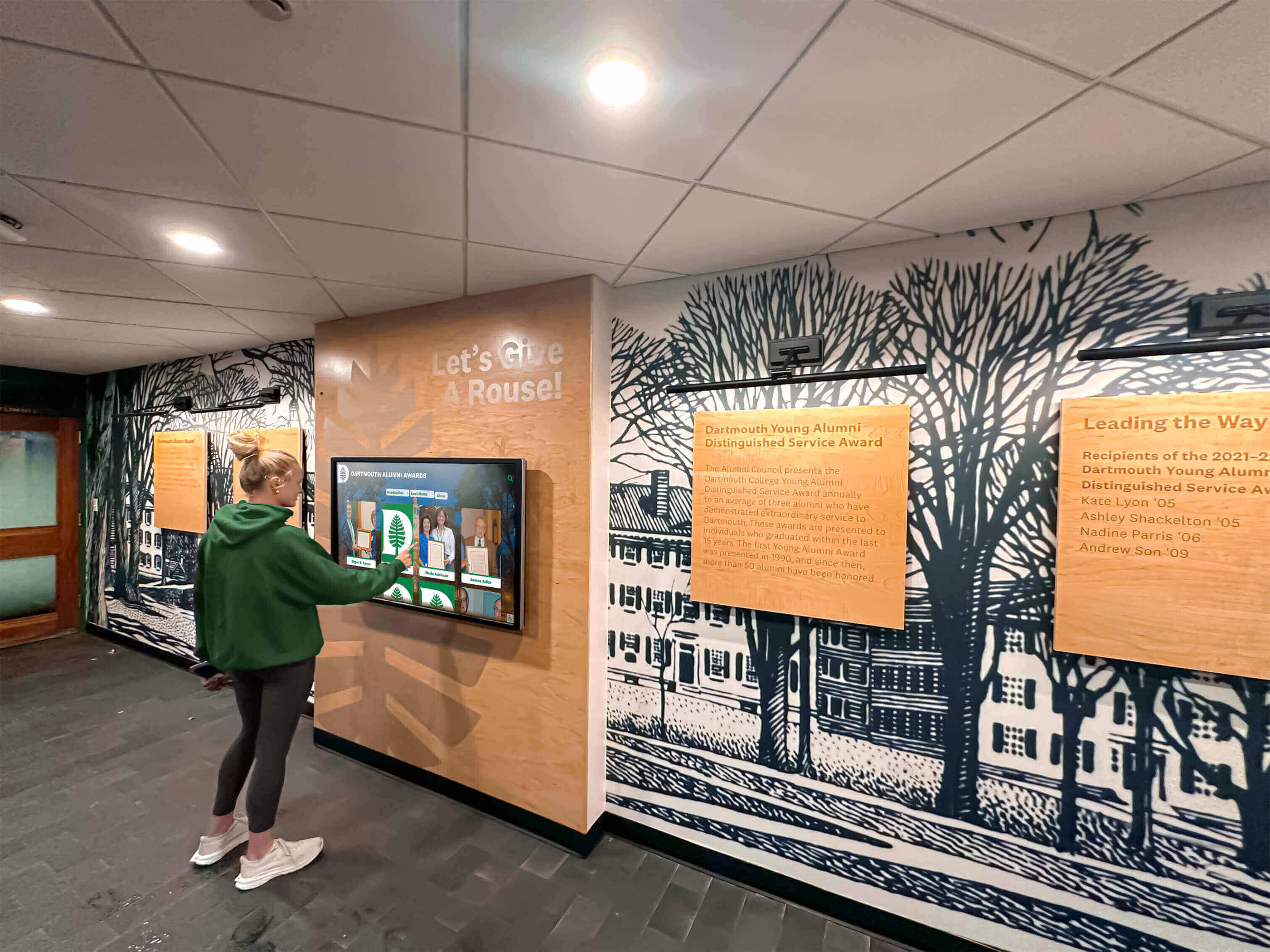
Multimedia Content Enhancement
Digital platforms support rich media far beyond text and static photographs.
Video Content Integration: Short video clips featuring honored students discussing their achievements, reflections on recognition, or advice for peers create engaging, personal content. Video humanizes recognition while providing content that performs well on social media when families share achievements.
Photo Galleries: Rather than single portrait shots, create galleries showing honorees in various contexts—classroom engagement, extracurricular activities, school events, or community service. Multiple images tell richer stories than isolated portraits while showcasing diverse contributions.
Timeline Visualizations: For students receiving repeated recognition or showing dramatic improvement, timeline graphics visualizing achievement progression over quarters or years communicate growth patterns compellingly. Visual representations of academic improvement or accumulating honors make progress tangible.
Achievement Badges and Icons: Visual symbols representing specific accomplishments—honor roll status, perfect attendance, community service hours, leadership roles, or subject excellence—provide quick recognition scanning while creating collectible elements motivating students to earn diverse badges over time.
Balancing Recognition Depth with Efficiency
While comprehensive profiles create impact, content development requires realistic sustainable approaches given staffing constraints.
Template-Based Approaches: Develop standardized profile templates ensuring consistent information inclusion while streamlining creation processes. Templates guide content gathering without requiring complete custom design for each honoree.
Incremental Content Addition: Launch programs with essential elements—photographs, names, basic achievement descriptions—and gradually add richer content as processes mature. Starting simple ensures sustainability while avoiding overwhelming initial implementation.
Student Involvement in Content Creation: Engage honorees in developing their own recognition content through structured questionnaires or reflection prompts. Student-generated content reduces staff workload while increasing authenticity and ownership.
Rolling Historical Completion: Focus initial efforts on current recognition while gradually digitizing historical Student of the Month archives over time. Spreading historical content creation across extended periods makes comprehensive archive building manageable.
Implementing Effective Selection Processes
Digital displays showcase recognition beautifully, but program credibility depends on fair, transparent selection ensuring worthy students receive acknowledgment.
Establishing Clear Criteria and Standards
Transparent criteria help students understand what behaviors and achievements earn recognition while ensuring consistent fair evaluation.
Academic Achievement Thresholds: For academically focused recognition, establish specific requirements—minimum GPA standards, honor roll achievement, specific grade improvements, or particular academic accomplishments. Objective criteria prevent perceptions of favoritism while creating clear targets students can pursue.
Character Trait Definitions: When recognizing character, define traits clearly with concrete behavioral examples. Rather than vague “good citizenship,” specify observable behaviors like “consistently helps classmates without prompting,” “demonstrates respect through active listening,” or “persists through challenging assignments without complaint.”
Nomination Requirements: Define who can nominate students—any staff member, specific teachers, students themselves, or combinations. Clear nomination processes ensure equitable consideration rather than recognition flowing primarily to students with advocates while others go unnoticed.
Balanced Category Rotation: Establish predictable category rotation ensuring diverse achievement types receive recognition across school years. If September focuses on academic improvement, October on character, and November on subject-specific excellence, students understand various pathways to potential recognition.
Grade-Level Equity: Ensure recognition opportunity distribution across grade levels. Programs dominated by upper-grade students fail to motivate younger pupils, while systems acknowledging at least one student per grade level maintain broad engagement.
Nomination and Selection Procedures
Systematic processes ensure thoughtful evaluation while remaining manageable given typical school workloads.
Faculty Nomination Process: Solicit nominations from all staff members teaching or supervising potential honorees. Broad nomination sourcing increases likelihood that deserving students receive consideration rather than recognition concentrating among students highly visible to limited individuals.
Selection Committee Review: Convene diverse selection committees—administrators, teachers from various departments, support staff, and potentially student representatives—reviewing nominations against established criteria. Committee approaches reduce individual bias while bringing multiple perspectives to evaluation.
Documentation Requirements: Request specific evidence supporting nominations—grade reports, improvement data, incident documentation, peer testimonials, or work samples—ensuring recognition bases on concrete evidence rather than general impressions.
Limit Repeat Recognition: Consider policies limiting how frequently individual students can receive Student of the Month honors, ensuring recognition spreads across broader populations. If the same handful of students receive repeated acknowledgment, motivational impact for most peers diminishes significantly.
Transparent Communication: Publish selection criteria, nomination processes, and general timing in student handbooks and communications. Transparency builds trust while helping students and families understand recognition as merit-based rather than mysterious or arbitrary.
Resources on implementing comprehensive recognition programs provide additional guidance for developing effective selection systems.
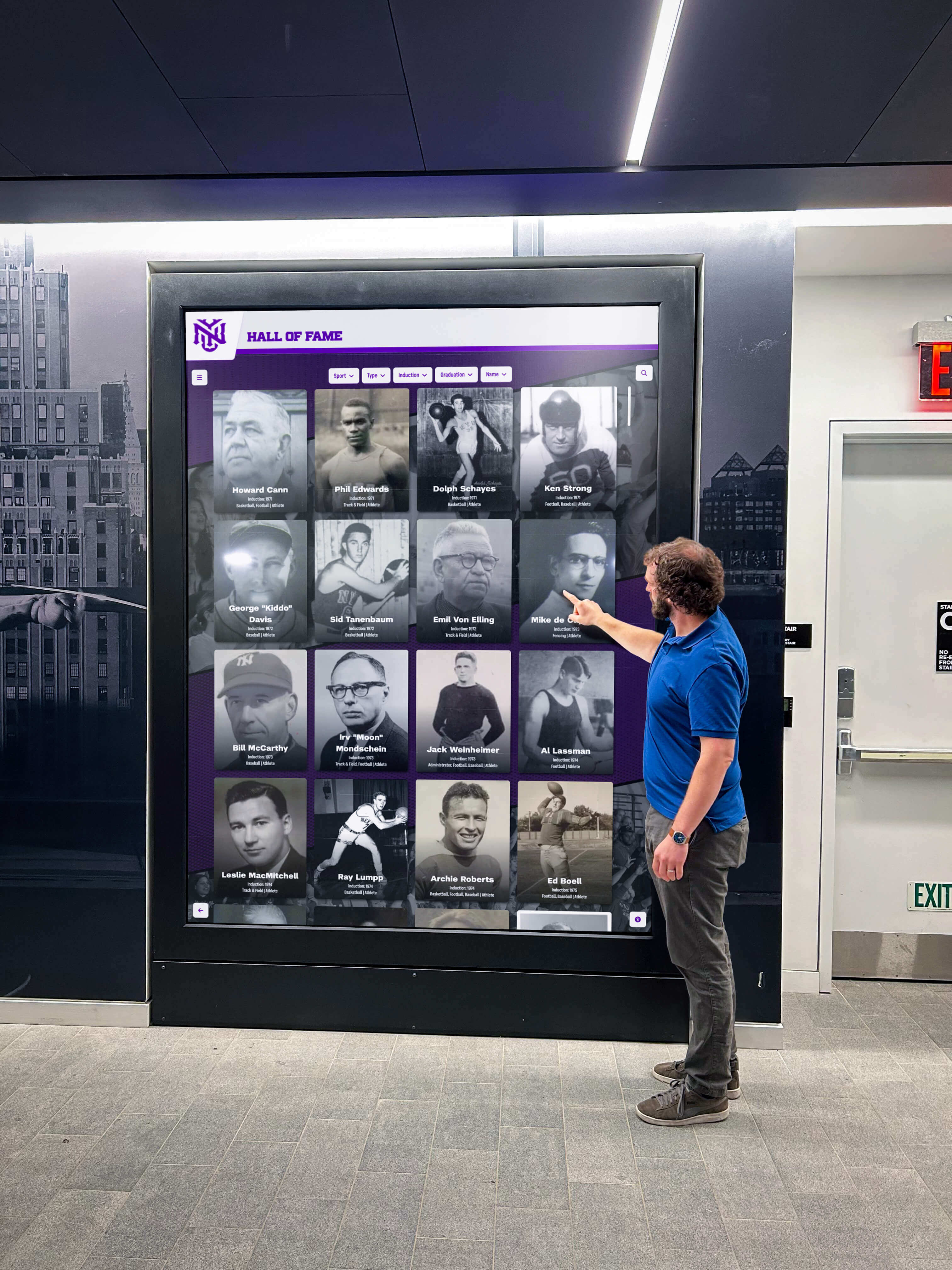
Maximizing Program Visibility and Engagement
Even beautifully designed digital recognition achieves limited impact if audiences remain unaware or disengaged. Effective programs employ multiple strategies ensuring consistent visibility.
Strategic Display Placement
Physical display location dramatically influences who sees recognition and how frequently.
High-Traffic Common Areas: Position displays in locations where students, staff, and visitors regularly gather—main lobbies, cafeteria entrances, media center entries, or primary hallway intersections. High-traffic placement ensures maximum exposure without requiring people to seek recognition content intentionally.
Multiple Location Strategy: Larger schools benefit from recognition displays in several locations rather than single installations. Elementary schools might install displays near main offices and cafeterias. High schools could place systems in different academic wings ensuring students whose schedules keep them in particular building areas still encounter recognition regularly.
Accessible Height and Positioning: Mount touchscreen displays at appropriate heights enabling comfortable interaction for youngest students through adults. Displays positioned too high frustrate shorter users, while excessive height prevents touching upper screen portions. Generally, bottom display edges should be approximately 36-42 inches from floor level.
Appropriate Context Consideration: Place recognition displays in areas where stopping to interact feels natural rather than disruptive. Displays immediately outside busy classrooms may receive limited interaction if users feel they block traffic, while locations in wider hallways or alcoves invite exploration without creating congestion.
Multi-Channel Communication Strategies
Complement physical displays with diverse communication approaches ensuring recognition reaches multiple audiences through various channels.
Morning Announcements Integration: Announce new Student of the Month honorees during daily morning announcements, directing audiences to digital displays or web platforms for complete profiles. Brief announcements create awareness while interactive platforms provide depth impossible during limited announcement time.
Website and Social Media Features: Feature Student of the Month recognition prominently on school websites and official social media channels. Homepage spotlights, dedicated recognition pages, and social posts amplify visibility while enabling family sharing extending reach into broader communities.
Email Communications: Send dedicated emails to school communities announcing new honorees with photographs and brief achievement descriptions linked to complete profiles on recognition platforms. Direct notification ensures families receive recognition news rather than relying on them to discover updates independently.
Newsletter Inclusions: Feature Student of the Month honorees in school newsletters with images and achievement summaries. Newsletter mentions preserve traditional communication channels some families prefer while directing interested readers to digital platforms for comprehensive content.
Parent-Teacher Conference Displays: Ensure recognition displays feature prominently during parent-teacher conferences, open houses, and other family engagement events. These occasions bring families on campus when they have time to explore recognition content thoroughly rather than hurried drop-off and pickup moments.
Research shows that 67% of teachers noticed improved information retention among students when using digital displays compared to traditional boards, and institutions with touchscreen display boards experienced a 30% reduction in administrative workload due to seamless updates and centralized data management.
Creating Recognition Culture
Technology and processes enable recognition, but cultural emphasis determines whether programs genuinely influence student motivation and school climate.
Ceremony and Celebration Rituals: Complement digital recognition with meaningful presentation ceremonies where honorees receive acknowledgment before peers, families, or school assemblies. Ceremonial elements create memorable experiences while reinforcing that recognition carries genuine significance institutionally.
Administrative Visibility and Endorsement: When principals, assistant principals, and other administrators consistently reference Student of the Month recognition in assemblies, morning announcements, and interactions, it signals institutional commitment. Leadership emphasis influences whether programs feel important or perfunctory.
Peer Recognition Systems: Enable students to nominate peers or express appreciation through digital platforms, creating participatory recognition cultures rather than purely top-down acknowledgment. Peer recognition complements official Student of the Month programs while broadening participation.
Connection to Other Recognition Programs: Integrate Student of the Month recognition with broader achievement acknowledgment—honor roll, athletic recognition, arts celebrations, service awards—creating comprehensive systems where achievement receives consistent visibility across diverse accomplishment types.
Schools implementing comprehensive digital recognition systems report positive cultural shifts as recognition becomes embedded in institutional identity rather than isolated monthly ritual.
Addressing Common Implementation Challenges
Schools predictably encounter obstacles when launching or improving Student of the Month digital recognition programs. Understanding common challenges enables proactive solutions.
Budget Constraints and Funding
Digital recognition technology requires initial investment that may challenge schools with constrained budgets.
Phased Implementation Approaches: Begin with modest systems—single display in highest-traffic location or web-only platform—and expand gradually as budgets allow. Phased approaches make programs financially manageable while demonstrating value justifying additional investment.
Multi-Purpose Technology Justification: Position recognition displays as serving multiple institutional communication needs beyond Student of the Month—daily announcements, event promotion, emergency notifications, wayfinding information—making investment easier to justify through diverse use cases.
Parent Organization Funding: Engage PTAs, booster clubs, or parent organizations in funding recognition technology. Many family groups willingly support initiatives directly benefiting student motivation and school culture, particularly when presented with clear connection to positive outcomes.
Grant Applications: Pursue educational technology grants from local foundations, corporate giving programs, or state education agencies. Many grant opportunities support initiatives enhancing student engagement, motivation, and school culture—outcomes digital recognition demonstrably achieves.
Alumni and Community Fundraising: Launch recognition-focused giving campaigns among alumni or community members who value celebrating student achievement. Dedicated fundraising positions recognition as investment in student success rather than general operational expense.
Technical Expertise Gaps
Concerns about technological complexity often deter schools from adopting digital recognition despite understanding potential benefits.
User-Friendly Platform Selection: Prioritize recognition systems specifically designed for non-technical educational users with intuitive interfaces requiring minimal training. Purpose-built educational platforms like those from Rocket Alumni Solutions offer straightforward content management accessible to typical school staff without specialized technical backgrounds.
Comprehensive Vendor Support: Select providers offering robust training, documentation, and ongoing technical support. Quality vendors understand that educational institutions have limited IT resources and design support systems accordingly through responsive help desks, video tutorials, and comprehensive guides.
Internal Champion Identification: Designate technology-comfortable staff members—not necessarily IT professionals but individuals comfortable with typical educational technology—as recognition program champions providing first-level support and advocacy. Champions help colleagues navigate platforms while troubleshooting common questions without requiring official IT department involvement.
Start Simple Philosophy: Launch with basic features mastering fundamental content management before attempting advanced capabilities. Successfully maintaining current recognition with photographs and descriptions builds confidence enabling gradual feature expansion as comfort increases.
Maintaining Content Quality and Consistency
Sustaining recognition quality over time as personnel change and competing priorities emerge challenges many programs.
Standard Operating Procedures: Document step-by-step processes for monthly recognition cycles—nomination solicitation timing, selection committee meeting schedules, content gathering approaches, digital platform update procedures, and communication protocols. Written procedures ensure consistency surviving personnel transitions.
Content Templates and Standards: Create standardized profile templates with required fields, recommended photograph specifications, achievement description guidelines, and quality standards. Templates maintain consistency while streamlining content creation reducing effort required for each honoree.
Assigned Responsibilities and Accountability: Clearly designate specific individuals or positions responsible for recognition program elements rather than assuming collective responsibility. When nobody owns particular tasks, they often fall through cracks during busy periods. Explicit accountability ensures completion.
Calendar-Based Reminder Systems: Establish automated reminders at appropriate points in monthly cycles prompting responsible parties about upcoming deadlines—nomination solicitation, selection meeting scheduling, content collection, display updates. Automated reminders prevent recognition delays when busy schedules obscure approaching deadlines.
Annual Program Review: Conduct comprehensive review annually assessing what worked well, identifying improvement opportunities, gathering stakeholder feedback, and making strategic adjustments. Regular evaluation prevents gradual program drift while demonstrating ongoing commitment to quality recognition.
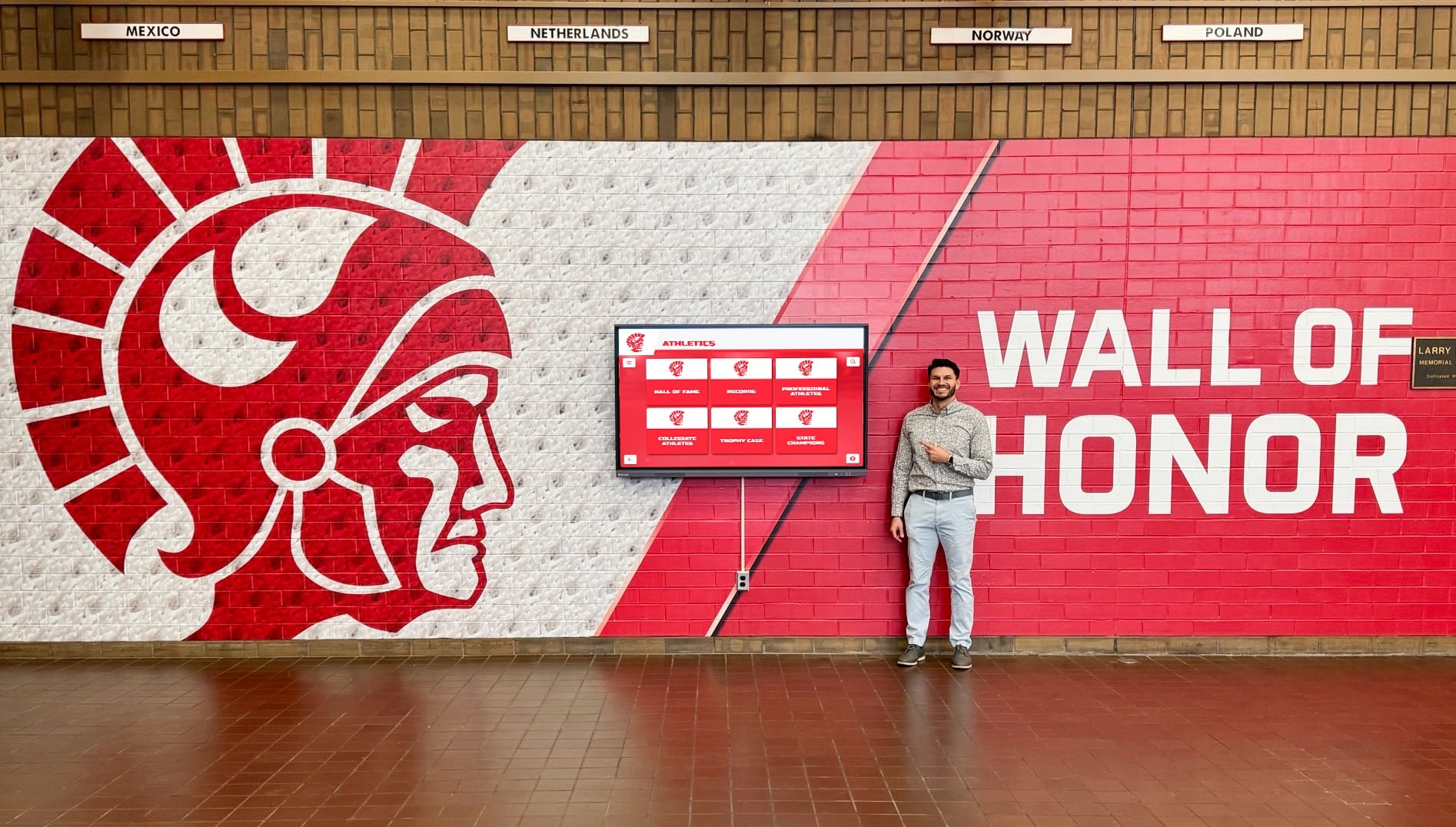
Measuring Recognition Program Success
Effective programs assess impact through multiple measures, ensuring recognition achieves intended objectives while justifying continued investment.
Quantitative Success Indicators
Participation Metrics: Track the number and percentage of students receiving Student of the Month recognition annually. Effective programs acknowledge diverse students across grade levels, demographics, and achievement types rather than repeatedly recognizing small groups.
Demographic Distribution Analysis: Examine recognition distribution across demographic categories—gender, ethnicity, socioeconomic status, English language learner status, special education services—ensuring equitable opportunity rather than systematic exclusion of particular populations.
Engagement Statistics: For digital platforms, monitor usage analytics—display interactions, profile views, search queries, average session duration, web platform visits, and social media engagement. These metrics indicate whether recognition genuinely captures attention or exists invisibly despite implementation.
Family Communication Response: Track responses to recognition communications—email open rates, website traffic following announcements, social media engagement, and attendance at recognition ceremonies. Family engagement indicates that recognition resonates beyond students themselves.
Qualitative Impact Assessment
Beyond numbers, recognition programs influence school culture through less quantifiable but equally important mechanisms.
Student Motivation and Aspiration: Survey students about whether Student of the Month recognition motivates them, whether they understand how to earn recognition, and whether they perceive selection as fair. Student perceptions determine whether programs genuinely influence motivation or feel irrelevant to their experiences.
Staff Observations: Gather faculty feedback about program effectiveness, nomination process usability, and observed impacts on student behavior or motivation. Staff members see recognition influence daily in ways administrators cannot observe directly.
Family Feedback: Solicit family perspectives about recognition program quality, communication effectiveness, and meaning to students and families. Family satisfaction indicates recognition successfully extends beyond campus boundaries creating broader community engagement.
School Culture Indicators: Assess broader cultural elements potentially influenced by recognition—student sense of belonging, school pride measures, perceptions of adult support, and beliefs that effort leads to acknowledgment. Recognition contributes to positive culture when students perceive that schools notice them, value their contributions, and celebrate their achievements.
Advanced Recognition Program Features
Once basic Student of the Month recognition operates smoothly, schools can implement enhanced features deepening impact and engagement.
Historical Archive Development
Digital platforms enable maintaining comprehensive recognition archives documenting honorees across decades, creating institutional tradition while enabling long-term engagement.
Complete Recognition Database: Retroactively digitize historical Student of the Month records from past years, creating searchable databases documenting complete program histories. Historical archives allow current students to discover which alumni previously earned recognition, families to find their own recognition years later, and institutions to demonstrate longstanding commitment to celebrating achievement.
Decade-Spanning Recognition Patterns: Analyze recognition patterns across extended periods identifying interesting trends—how selection criteria evolved, whether particular achievement types gained prominence, or how student demographics shifted over time. Historical analysis provides fascinating institutional insights while creating engaging content for anniversaries or celebrations.
Alumni Engagement Opportunities: Historical archives create natural alumni engagement touchpoints. Alumni visiting campuses can explore their own recognition, reunion communications can highlight who earned honors during particular graduating class years, and social media campaigns can feature throwback recognition from past decades.
Family Contribution Features
Enable family members to contribute personal perspectives or memories enhancing official recognition with intimate family context.
Family Tribute Messages: Allow families to add congratulatory messages, share personal perspectives on achievements, or contribute additional context through controlled submission systems. Family contributions make recognition more personal while increasing family investment in programs.
Extended Recognition Networks: Create optional features enabling honorees to share recognition notifications with extended family networks—grandparents, relatives in distant locations, family friends—who might not otherwise learn about achievements. Extended sharing amplifies recognition impact while creating positive school promotion.
Multi-Generational Recognition: For families with multiple children attending schools over years or even decades, create features showing all family members who earned recognition, building family legacies around achievement. Multi-generational recognition deepens family connections to institutions.
Integration with Broader Recognition Systems
Connect Student of the Month programs with comprehensive achievement acknowledgment systems.
Cumulative Achievement Tracking: Develop systems documenting all recognition students receive over their school careers—Student of the Month honors, honor roll achievement, subject awards, athletic recognition, arts acknowledgment, service milestones—creating complete recognition profiles. Comprehensive tracking enables end-of-year or graduation recognition highlighting cumulative accomplishment patterns.
Recognition Point Systems: Implement point systems where various achievements earn designated values contributing to cumulative totals. Student of the Month recognition might earn substantial points while honor roll, perfect attendance, or participation earn smaller amounts. Point systems create achievement gamification motivating diverse accomplishment pursuit.
Digital Achievement Portfolios: Enable students to build comprehensive achievement portfolios including recognition earned, work samples, project documentation, assessments, and reflections. Recognition becomes one element within broader documentation of growth and accomplishment throughout school experiences.
Schools implementing comprehensive recognition ecosystems report that integrated systems create greater impact than isolated programs operating independently.
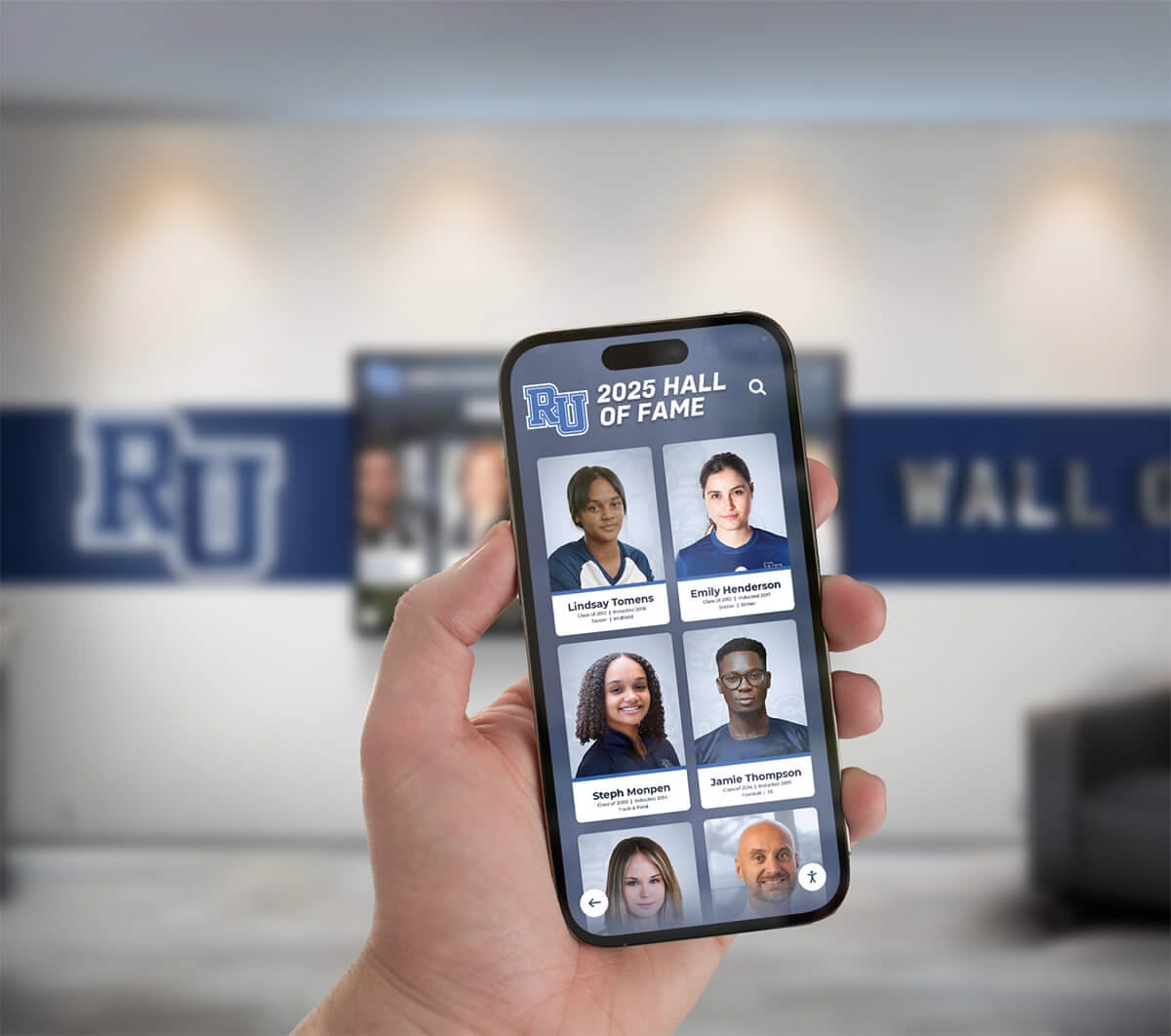
Future Trends in Student Recognition Technology
Digital recognition continues evolving as emerging technologies create new capabilities and possibilities.
Artificial Intelligence Applications
AI-powered systems will transform recognition program administration and personalization.
Automated Achievement Identification: AI systems analyzing integrated student data can automatically identify students meeting recognition criteria—GPA thresholds, attendance patterns, improvement metrics, or participation milestones—alerting administrators to potential honorees without manual data review. Automation ensures deserving students receive consideration rather than being overlooked when nominations depend solely on adult advocacy.
Predictive Recognition Opportunities: Machine learning algorithms can identify students approaching recognition milestones, enabling proactive encouragement. If a student needs one additional honor roll marking period to achieve yearly recognition or falls just short of GPA thresholds, predictive systems can alert counselors to provide targeted support pushing students over achievement lines.
Personalized Display Content: AI-enabled displays could recognize individual viewers through facial recognition or RFID badges, automatically showing personalized content—viewers’ own recognition histories, classmates’ achievements, or historically similar honorees. Personalization creates individualized relevance increasing engagement.
Blockchain Verification and Digital Credentials
Permanent, verifiable achievement records are becoming increasingly important in educational contexts.
Tamper-Proof Achievement Documentation: Blockchain-based systems create permanent, unalterable records of recognition students earned, providing verifiable documentation for future college applications, scholarship opportunities, or employment. Verified credentials carry greater weight than self-reported achievements on resumes.
Portable Digital Badges: Student of the Month recognition could generate digital badges students collect in personal portfolios, share on social media, or include in college applications through standardized credential platforms. Portable badges extend recognition utility beyond immediate school contexts.
Micro-Credential Stackability: Recognition could tie to competency-based credential systems where achievements demonstrate mastery of specific skills or character traits. Stackable micro-credentials create achievement pathways with practical value beyond symbolic acknowledgment.
Enhanced Family Engagement Platforms
Recognition technology will deepen family connections through more sophisticated engagement features.
Mobile Recognition Notifications: Real-time mobile app notifications immediately alert families when students earn recognition, receive nominations, or achieve milestones. Instant notification enables timely family celebration while keeping parents informed about school experiences.
Augmented Reality Experiences: AR-enabled mobile apps could overlay additional content when families point devices at physical recognition displays—video interviews appearing over static photos, 3D visualizations of achievement data, or interactive elements enhancing physical installations.
Video Integration: As bandwidth and storage costs decrease, video will become standard recognition elements rather than special features. Every Student of the Month profile could include video interviews, classroom footage, or project presentations creating rich multimedia recognition.
Conclusion: Building Recognition Cultures That Inspire Excellence
Academic Student of the Month digital display programs represent far more than replacing paper certificates with touchscreens. When implemented thoughtfully, these programs create systematic recognition cultures that validate achievement, motivate continued excellence, strengthen student belonging, communicate institutional values, engage families meaningfully, and build school traditions celebrating accomplishment across generations.
Effective digital recognition programs share common characteristics regardless of specific technology platforms or implementation details:
- Clear, fair criteria ensuring recognition feels merit-based rather than arbitrary
- Rich multimedia content telling complete achievement stories beyond name listings
- Strategic visibility ensuring recognition reaches multiple audiences through various channels
- Sustainable processes maintaining program quality surviving personnel transitions
- Integration with broader school culture rather than isolated monthly rituals
- Continuous assessment and improvement based on outcome measurement
The investment schools make in digital Student of the Month recognition yields returns in student motivation, school culture, family engagement, and community pride. Recognition communicates that schools notice students, value their efforts, celebrate their accomplishments, and believe in their potential. During formative school years when young people develop identities and relationships with learning, consistent meaningful recognition helps shape positive trajectories extending far beyond classroom walls.
Modern solutions like Rocket Alumni Solutions provide comprehensive platforms specifically designed for educational recognition, offering intuitive content management, engaging interactive displays, proven implementation approaches, and ongoing support helping schools build recognition cultures their students deserve. Whether implementing touchscreen displays, web-based platforms, or hybrid systems, digital technology enables schools to celebrate Student of the Month honorees more comprehensively and effectively than traditional approaches ever allowed.
Ready to transform how your school celebrates student achievement? Explore comprehensive digital recognition solutions that honor excellence while building school cultures where all students feel valued, motivated, and inspired to reach their highest potential. Your students accomplish remarkable things every day—effective Student of the Month digital display programs ensure those achievements receive the meaningful, visible, lasting recognition they deserve.
